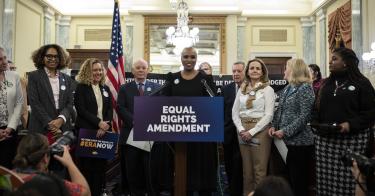Wishful thinking is alive and well on Capitol Hill. Case in point: The Senate Judiciary Committee will hold a hearing on February 28 titled “The Equal Rights Amendment: How Congress Can Recognize Ratification and Enshrine Equality in Our Constitution.”
This hearing is intended to push the fiction that Congress has any authority to resurrect the ERA that it proposed in 1972, but that expired more than 40 years ago.
Article V of the U.S. Constitution gives Congress two powers in the constitutional amendment process. First, “whenever two thirds of both Houses shall deem it necessary,” Congress may propose amendments. In Dillon v. Gloss, the Supreme Court expressed “no doubt” that this includes setting a ratification deadline. Second, Congress may dictate the “Mode of Ratification,” that is, whether states must ratify a proposed amendment in their legislatures or by conventions.
That’s it. Once it has proposed a constitutional amendment, including any ratification deadline and designating the mode of ratification, Congress has no role or authority whatsoever.
>>> The ERA Has Just One Purpose Left: Abortion
Congress exercised these powers in March 1972 by proposing the Equal Rights Amendment with a seven-year deadline for state legislatures to ratify it. A total of 35 states did so by January 1977, although five of them quickly rescinded their approval. This was fewer than the 38 required by the Constitution for ratification. Knowing that the March 1979 deadline was both looming and binding, ERA supporters pushed Congress to pass a resolution extending that deadline to June 30, 1982.
The only court to address the issue found the extension unconstitutional. Not only does Congress lack authority to change a deadline after an amendment has been proposed, but Congress passed this extension resolution with fewer than the two-thirds of both houses required by the Constitution.
In any event, no new states ratified the ERA and, as the Congress Research Service has stated many times that the ERA “formally died on June 30, 1982.”
Supporters, however, are still searching for vital signs. They actually claim the 1972 ERA is now part of the Constitution after three states passed “ratification” resolutions in the last several years, long after the termination date.
The late Justice Ruth Bader Ginsburg, an ERA booster, easily exposed the problem with this position. In a 2020 interview, she said that “[i]f you count a latecomer on the plus side, how can you disregard states that [rescinded ratification]?” Applying Ginsburg Math, only 33 states have ratified the 1972 ERA. No wonder, then, why Ginsburg concluded that ERA proponents should start over.
But they’re not done, which brings us to the Senate Judiciary Committee hearing, which will focus on a resolution introduced by Sen. Ben Cardin (D-MD) that purports to remove the 1972 ERA’s ratification deadline and declare that it has been ratified by 38 states.
Senators should re-read Article V. A proposed constitutional amendment becomes part of the Constitution upon ratification by three-fourths of the states; no congressional action can affect ratification in any way.
On that point, Democrats should also check in with their favorite liberal constitutional scholars. The late professor, and former Acting Solicitor General, Walter Dellinger, for example, has written that Article V “requires no additional action by Congress or by anyone else after ratification by the final state. The creation of a ‘third step’ – promulgation by Congress – has no foundation in the text of the Constitution.”
Senate Democrats face another awkward situation. Under federal law, when notified “that any amendment proposed to the Constitution … has been adopted, according to the provisions of the Constitution,” the archivist of the United States must “cause the amendment to be published … as a part of the Constitution.” The Archivist declined to publish the 1972 ERA because, as advised by the Justice Department’s Office of Legal Counsel, it “is no longer pending before the States.”
Alabama and Illinois sued the archivist in December 2019, seeking a final declaration on whether the 1972 ERA had been finally ratified. U.S. District Judge Rudolph Contreras dismissed the lawsuit in March 2021, holding that “Congress set deadlines for ratifying the ERA that expired long ago.” The states appealed, and the case is before the U.S. Court of Appeals for the District of Columbia.
Because the archivist is an executive branch official, the Biden Justice Department is defending him and filed its brief in March 2022. Here are some of the Biden administration’s arguments that should be raised before the Senate Judiciary Committee.
First, citing a law journal article by then-Professor Ginsburg, the Department observed that even the 1972 ERA’s congressional sponsors saw adding a ratification deadline as a “customary statute of limitations.”
>>> Respecting Constitution Requires Acknowledging Death of 1972 ERA
Second, “Congress acted consistent with established practice by fixing that [ratification] period through the” proposing clause of the ERA resolution.
Third, a proposed constitutional amendment “is complete when three-fourths of the States properly ratify [it].”
Fourth, those arguing “that the ERA has been validly adopted notwithstanding the congressional deadline … have not identified any relevant legal authority establishing that this is so.”
Fifth, “the question of the ERA’s validity is, at best, uncertain” and “Congress has repeatedly acted on the assumption that the deadline is valid.”
It should take more than an imagination and a political agenda to properly interpret and apply the Constitution. Congress had authority to set a ratification deadline for the 1972 ERA and, when it did so at the suggestion of ERA supporters, everyone understood that the deadline was valid and binding.
Because that deadline passed with insufficient state support, the 1972 ERA died more than four decades ago. It is no longer pending before the states for ratification, and no longer pending before Congress for amendment. It is dead.
This piece originally appeared in the Daily Wire




